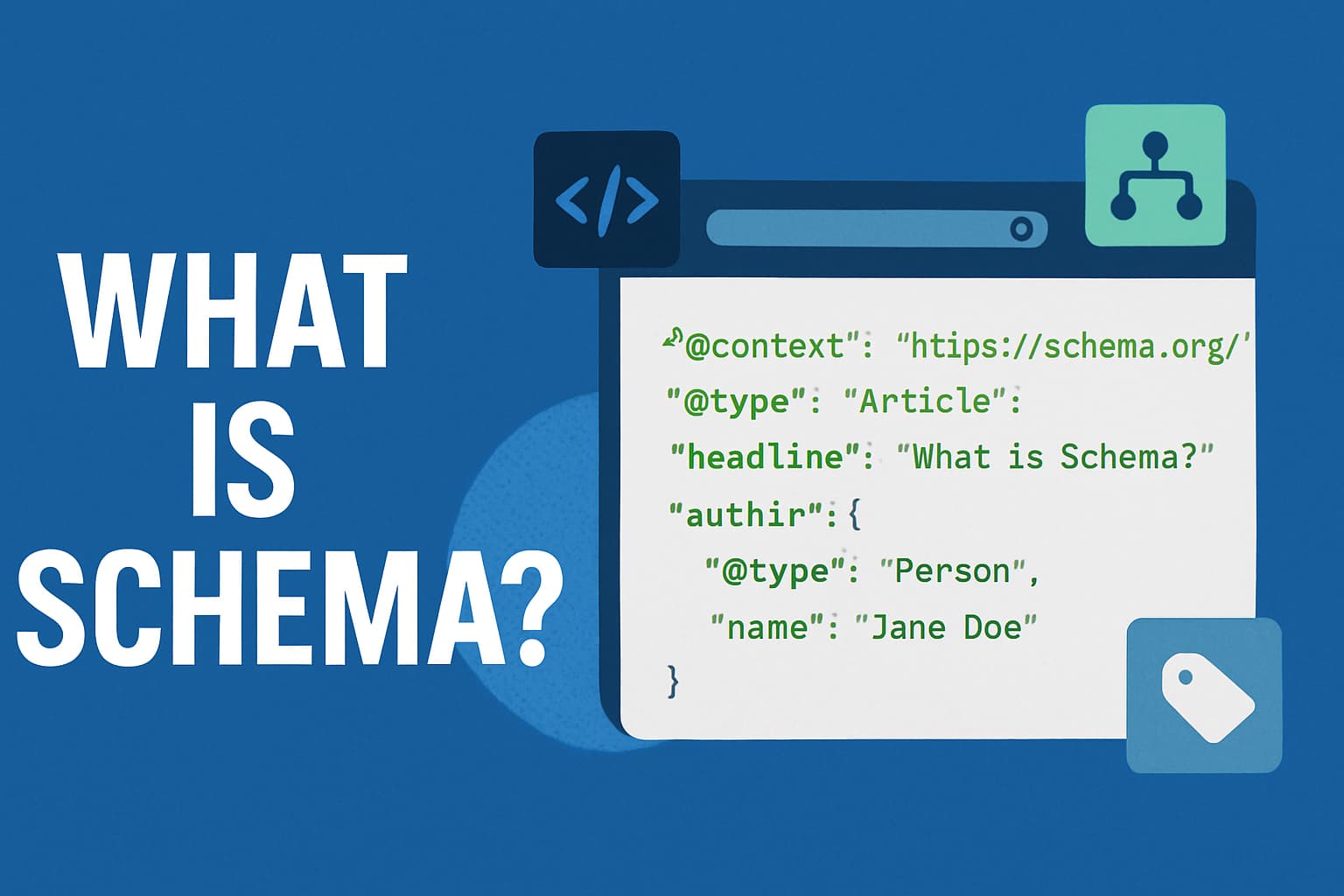Imagine you’ve written a brilliant article, spent hours choosing the right keywords, and yet your page sits quietly on page five of Google. You’re not alone. Sometimes, search engines just don’t get what your content is about — not because it’s bad, but because they can’t interpret it like humans do. That’s where schema markup steps in. It’s like giving Google a neatly labeled map instead of a messy notebook.
The Short Version: Schema Helps Search Engines Read Between the Lines
Search engines read code, not emotion. When you say, “I reviewed the new iPhone,” a human understands it’s a product review. But for a crawler, it’s just text — no context, no hierarchy. Schema markup gives that sentence meaning by tagging it as a “Product” with properties like “name,” “brand,” and “reviewRating.”
It’s structured data — a standardized way of organizing information so that machines can understand it better. Schema tells Google what your data means, not just what it says.
Schema Is the Bridge Between Your Words and Google’s Understanding
Schema isn’t new. It started back in 2011 when Google, Bing, Yahoo!, and Yandex teamed up to create Schema.org, a shared vocabulary for structured data. Think of it as a dictionary that both humans and algorithms agreed upon.
You can describe almost anything using schema: a person, a local business, a movie, a product, or even an FAQ section. It’s versatile, lightweight, and surprisingly underused — especially among small businesses that rely heavily on SEO.
The goal? To help your content stand out with rich results — those star ratings, FAQs, images, and other visual enhancements that grab attention in search results.
Why Schema Matters More Than Most People Think
Schema markup doesn’t directly boost your ranking (Google confirmed that). But here’s the twist — it indirectly improves performance. Why? Because richer search snippets lead to higher click-through rates (CTR). And when more people click your result, Google sees it as a positive engagement signal.
You’ve seen it before — snippets showing:
- Ratings under a product
- Cooking times under a recipe
- Event dates or prices under a listing
Those aren’t random design perks; they’re schema-driven enhancements. They make your listing more visually appealing and informative at a glance — a subtle yet powerful edge.
And in competitive niches like e-commerce or local services, that edge often makes the difference between a click and a scroll.
Types of Schema You’ll Actually Use
Not every schema type fits every website. But here are the most practical ones that deliver results:
- Article Schema: For blogs, news, or editorial content — adds publisher info, date, and author.
- Product Schema: For e-commerce — includes price, availability, and reviews.
- Review Schema: Helps display star ratings or user opinions.
- Local Business Schema: Critical for local SEO — includes address, contact info, and business hours.
- FAQ Schema: Expands your result with collapsible questions and answers.
- Event Schema: Perfect for concerts, webinars, or workshops — adds event name, date, and location.
- HowTo Schema: Great for tutorials or DIY content — shows step-by-step instructions right on Google.
Here’s the thing — even one or two of these, implemented correctly, can significantly change how your pages appear in search results.
How Schema Actually Works Behind the Curtain
When you add schema to your webpage, it sits in the background as a block of structured code — usually JSON-LD format (JavaScript Object Notation for Linked Data).
Google crawlers read that markup and match it with your on-page content. If it finds consistency and relevance, it uses that data to enhance your listing.
JSON-LD is currently Google’s favorite format because it’s clean, separate from your HTML, and easy to maintain.
Example snippet for a local business:
{
“@context”: “https://schema.org”,
“@type”: “LocalBusiness”,
“name”: “xyzDigital”,
“address”: {
“@type”: “PostalAddress”,
“streetAddress”: “42 MG Road”,
“addressLocality”: “bngr”,
“addressCountry”: “IN”
},
“telephone”: “+91-9876543210”
}
Simple, right? Yet that tiny block of code can tell Google exactly who you are, where you’re located, and what you do.
How to Add Schema — Without Breaking Your Site
If you’re using WordPress, life gets easier. Plugins like Rank Math, Yoast SEO, and Schema Pro add structured data automatically. You can select schema types per page or post, and they handle the coding behind the scenes.
For custom-built websites or CMS platforms, you can manually embed JSON-LD snippets in your <head> section.
After implementation, always test your markup using:
- Google’s Rich Results Test: https://search.google.com/test/rich-results
- Schema Markup Validator: https://validator.schema.org/
These tools tell you if your schema is valid and whether Google can generate rich results from it.
Common Schema Mistakes That Quietly Hurt SEO
Many marketers fall into these traps:
- Assuming schema is a ranking factor. It’s not — it’s a clarity factor.
- Copy-pasting schema from other sites without adjusting key details.
- Adding schema that doesn’t match on-page content. Google flags that as misleading.
- Skipping validation. One typo in the JSON can break the entire markup.
A clean, consistent schema tells Google, “Hey, I know what I’m talking about.” A sloppy one? That says, “I copied this from somewhere.”
Schema and the Rise of AI Search
Here’s where it gets interesting. With Google’s Search Generative Experience (SGE) and AI-driven summaries, structured data is becoming more important than ever.
Why? Because AI systems rely on context-rich metadata to decide what information to highlight or summarize. Schema provides that context.
It also powers voice search — when you ask your phone for “the nearest coffee shop open now,” schema helps identify which businesses meet that intent.
So, while schema started as a technical SEO tool, it’s quietly turning into a language that AI understands too.
Schema Isn’t Just Code — It’s Storytelling in Structure
Think of schema as the punctuation in your website’s story. It doesn’t write the story for you; it gives it rhythm and clarity.
Without it, your site’s narrative gets lost in translation — Google sees a collection of words. With it, your content has identity, relevance, and structure.
For small businesses, that’s huge. You might not compete with big brands in ad budgets, but with a strong schema strategy, you can compete in clarity — and clarity wins clicks.
The Bottom Line
Schema is one of those SEO tactics that feels “extra” until you see the difference it makes. It’s technical, yes, but also deeply human in purpose — it helps machines understand our stories better.
If you’re serious about visibility, don’t treat schema like an optional tag. Treat it like a translator that makes your digital voice clear, confident, and unmistakable.
Start with one page — your homepage or a key service page. Test it. Watch how your snippets change. Then expand.
Because once search engines truly understand you, your audience will too.
Also check
FAQs
What is schema in SEO?
Schema in SEO refers to structured data markup added to a webpage’s code to help search engines understand the meaning and purpose of its content. It organizes data so that Google can present it more effectively in search results — often through rich snippets like ratings, FAQs, and product details.
Does schema markup improve Google rankings?
Schema markup doesn’t directly improve rankings, but it enhances how your page appears in search results. By enabling rich snippets and detailed previews, schema increases visibility and click-through rates, which can indirectly strengthen your overall SEO performance.
What are the most common types of schema markup?
Some of the most used schema types include Article, Product, Review, Local Business, FAQ, Event, and HowTo. Each serves a different purpose — from highlighting business details to displaying how-to steps or event schedules right on Google.
How do I add schema to my website?
You can add schema manually using JSON-LD code within your page’s HTML or by using SEO plugins such as Rank Math, Yoast SEO, or Schema Pro on WordPress. Once added, validate it using Google’s Rich Results Test or the Schema Markup Validator.
What is the difference between schema and structured data?
Structured data is the general term for organizing information in a machine-readable format, while schema is the vocabulary or set of definitions used to label that data. In short — schema is the language, and structured data is the message written in that language.
Why is schema important for AI and voice search?
Schema provides context that helps AI-driven systems and voice assistants understand content more precisely. When users ask questions verbally or through generative search, schema helps search engines identify accurate and relevant answers faster.

